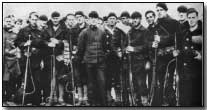Encyclopedia - Dunnite
 Dunnite was the name of a
high explosive used by the United States during World War One (and in use
from 1906 when it replaced use of maximite). The substance was named
after its designer, Major Dunn, but was also commonly referred to as
'Explosive D'.
Dunnite was the name of a
high explosive used by the United States during World War One (and in use
from 1906 when it replaced use of maximite). The substance was named
after its designer, Major Dunn, but was also commonly referred to as
'Explosive D'.
Dunnite was comprised of ammonium picrate powder and was regarded as an insensitive substance. Consequently in field use it was deployed by the U.S. Navy in armour-piercing artillery shells and projectiles, and was also used in coastal defence.
Its advantage was that it typically did not detonate when coming into contact with heavy armour. Instead the shell within which it was encased first tore open such protective armour: a fuse would then be triggered which produced the required detonation.
This was in marked contrast to another widely used high explosive of the period, Lyddite, which tended to detonate while the projectile was in the process of tearing through armour defences (although Lyddite was somewhat more powerful than Dunnite).
Photograph courtesy of Photos of the Great War website
A "blimp" was a word applied to an observation balloon.
- Did you know?
